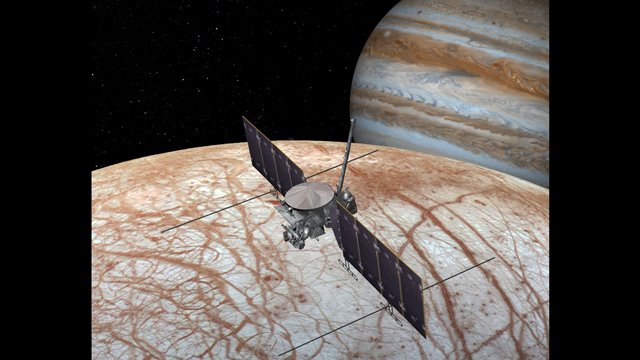NASA will present new discoveries about the ocean worlds in our solar system on Thursday, the agency announced. Learning more about ocean worlds could help in the agency’s quest for life beyond Earth.
The findings were gathered by researchers through the Hubble Space Telescope and Cassini spacecraft. Cassini has been orbiting Saturn since 2004, and the mission ends this year.
“During its time at Saturn, Cassini has made numerous dramatic discoveries, including a global ocean that showed indications of hydrothermal activity within the icy moon Enceladus, and liquid methane seas on its moon Titan,” NASA said in a release.
Earth is considered an ocean world because those bodies of water cover the majority of the planet’s surface. Other ocean worlds in our solar system potentially include Jupiter’s moons Europa, Ganymede and Callisto; Saturn’s moons Enceladus, Mimas and Titan; Neptune’s moon Triton; and the dwarf planet Pluto.
It is believed that Venus and Mars were once ocean worlds, but the greenhouse gas effect and a vulnerable atmosphere, respectively, caused those planets to lose them.
The Europa mission
NASA plans to further explore ocean worlds in our solar system, including through the recently named Europa Clipper mission. This mission will investigate Jupiter’s moon Europa, which has a salty liquid water ocean containing twice as much water as Earth’s oceans beneath an icy crust.
Researchers want to know whether Europa could support life in its ocean. They spotted water plumes rising 125 miles above the surface in September using the Hubble Telescope.
Europa could be the best case for life in our solar system outside of Earth, said Britney Schmidt, assistant professor at the Georgia Institute of Technology’s School of Earth and Atmospheric Sciences.
Schmidt is also one of the architects of the project that became the Europa Clipper mission. She and two other researchers came up with the name while sitting in a hotel room during a conference.
The Europa Clipper, named for the innovative, streamlined ships of the 1800s, will launch in the 2020s and arrive at Europa after a few years.
“The reason we chose it is because the clipper ships were fast, American boats at the time that they were first used, when most shipping was achieved with large, slow vessels,” Schmidt said. “We liked clipper for that reason, an ingenious way to solve the Europa mission problem: How do you get a long-lived mission at Europa with global coverage but not be in the radiation environment?”
Because that region of the solar system traps atomic particles from the sun, the radiation of the area around Jupiter is dangerous to spacecraft.
Schmidt will be an investigator for the ice-penetrating radar instrument that will be housed on the Europa Clipper. It will act like an X-ray, peering through the unknown thickness of Europa’s icy crust the same way scientists use earthquakes to assess the interior of the Earth.
Research suggesting the possibility of an ocean on Europa was published as early as 1977, after the Voyager mission saw long lines and dark spots, as opposed to a cratered surface similar to other moons. Then the Galileo mission reached Europa in 1996 and revealed for the first time that there was an ocean on another planet.
But because neighboring Mars has fueled imaginations and the possibility of exploring another planet for years, the general public hasn’t been as captivated by Jupiter’s moon. There are arguments that life could exist on Mars, but it was most likely habitable in the past, when it supported bodies of water and had a more hospitable climate and an atmosphere.
“The question is, do you want to study something that might have been habitable at one time, or do you want to study something that could be habitable right now?” Schmidt asked. “Europa has been pretty much Europa for 4.5 billion years, as long as the Earth has. So as far as what could have started and evolved there, that’s a compelling question.
“If you think about early Earth and early Europa, they were probably very similar, at least at the ocean interface. They are almost the same place at that point in time. That’s why I get excited about Europa. It could have been a place for life over the history of the solar system.”
